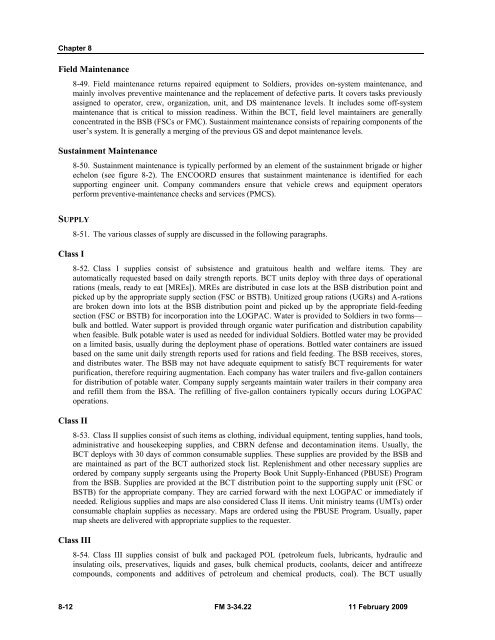FM 3-34.22 - Army Electronic Publications & Forms - U.S. Army
FM 3-34.22 - Army Electronic Publications & Forms - U.S. Army
FM 3-34.22 - Army Electronic Publications & Forms - U.S. Army
You also want an ePaper? Increase the reach of your titles
YUMPU automatically turns print PDFs into web optimized ePapers that Google loves.
Chapter 8<br />
Field Maintenance<br />
8-49. Field maintenance returns repaired equipment to Soldiers, provides on-system maintenance, and<br />
mainly involves preventive maintenance and the replacement of defective parts. It covers tasks previously<br />
assigned to operator, crew, organization, unit, and DS maintenance levels. It includes some off-system<br />
maintenance that is critical to mission readiness. Within the BCT, field level maintainers are generally<br />
concentrated in the BSB (FSCs or <strong>FM</strong>C). Sustainment maintenance consists of repairing components of the<br />
user’s system. It is generally a merging of the previous GS and depot maintenance levels.<br />
Sustainment Maintenance<br />
8-50. Sustainment maintenance is typically performed by an element of the sustainment brigade or higher<br />
echelon (see figure 8-2). The ENCOORD ensures that sustainment maintenance is identified for each<br />
supporting engineer unit. Company commanders ensure that vehicle crews and equipment operators<br />
perform preventive-maintenance checks and services (PMCS).<br />
SUPPLY<br />
Class I<br />
8-51. The various classes of supply are discussed in the following paragraphs.<br />
8-52. Class I supplies consist of subsistence and gratuitous health and welfare items. They are<br />
automatically requested based on daily strength reports. BCT units deploy with three days of operational<br />
rations (meals, ready to eat [MREs]). MREs are distributed in case lots at the BSB distribution point and<br />
picked up by the appropriate supply section (FSC or BSTB). Unitized group rations (UGRs) and A-rations<br />
are broken down into lots at the BSB distribution point and picked up by the appropriate field-feeding<br />
section (FSC or BSTB) for incorporation into the LOGPAC. Water is provided to Soldiers in two forms—<br />
bulk and bottled. Water support is provided through organic water purification and distribution capability<br />
when feasible. Bulk potable water is used as needed for individual Soldiers. Bottled water may be provided<br />
on a limited basis, usually during the deployment phase of operations. Bottled water containers are issued<br />
based on the same unit daily strength reports used for rations and field feeding. The BSB receives, stores,<br />
and distributes water. The BSB may not have adequate equipment to satisfy BCT requirements for water<br />
purification, therefore requiring augmentation. Each company has water trailers and five-gallon containers<br />
for distribution of potable water. Company supply sergeants maintain water trailers in their company area<br />
and refill them from the BSA. The refilling of five-gallon containers typically occurs during LOGPAC<br />
operations.<br />
Class II<br />
8-53. Class II supplies consist of such items as clothing, individual equipment, tenting supplies, hand tools,<br />
administrative and housekeeping supplies, and CBRN defense and decontamination items. Usually, the<br />
BCT deploys with 30 days of common consumable supplies. These supplies are provided by the BSB and<br />
are maintained as part of the BCT authorized stock list. Replenishment and other necessary supplies are<br />
ordered by company supply sergeants using the Property Book Unit Supply-Enhanced (PBUSE) Program<br />
from the BSB. Supplies are provided at the BCT distribution point to the supporting supply unit (FSC or<br />
BSTB) for the appropriate company. They are carried forward with the next LOGPAC or immediately if<br />
needed. Religious supplies and maps are also considered Class II items. Unit ministry teams (UMTs) order<br />
consumable chaplain supplies as necessary. Maps are ordered using the PBUSE Program. Usually, paper<br />
map sheets are delivered with appropriate supplies to the requester.<br />
Class III<br />
8-54. Class III supplies consist of bulk and packaged POL (petroleum fuels, lubricants, hydraulic and<br />
insulating oils, preservatives, liquids and gases, bulk chemical products, coolants, deicer and antifreeze<br />
compounds, components and additives of petroleum and chemical products, coal). The BCT usually<br />
8-12 <strong>FM</strong> 3-<strong>34.22</strong> 11 February 2009

















